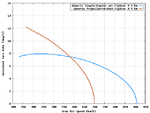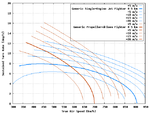Hi everyone,
Since we've had serveral threads on jet fighter vs. propeller fighter turning battles on this board in the recent past, I thought a comparison of their basically different charactistics might be interesting.
The attached graph is the result of a simplified calculation for the turn rate fo two generic fighters, the jet fighter patterned loosely after the Heinkel He 162, and the propeller fighter loosely after typical US single-engined fighters.
I have not attempted to match the historical parameters accurately to avoid opening several cans of worms at once.
The basic difference between jet fighter and propeller-drive fighter is the thrust-over-speed function, with propellers yielding good thrust at low speed but dropping off at higher speeds, while jets provide roughly constant thrust over the entire speed range. In WW2, the absolute thrust of jets was not very high, so at low speed they compared unfavourably against the traditional piston-engine/propeller combination.
Regards,
Henning (HoHun)
Since we've had serveral threads on jet fighter vs. propeller fighter turning battles on this board in the recent past, I thought a comparison of their basically different charactistics might be interesting.
The attached graph is the result of a simplified calculation for the turn rate fo two generic fighters, the jet fighter patterned loosely after the Heinkel He 162, and the propeller fighter loosely after typical US single-engined fighters.
I have not attempted to match the historical parameters accurately to avoid opening several cans of worms at once.
The basic difference between jet fighter and propeller-drive fighter is the thrust-over-speed function, with propellers yielding good thrust at low speed but dropping off at higher speeds, while jets provide roughly constant thrust over the entire speed range. In WW2, the absolute thrust of jets was not very high, so at low speed they compared unfavourably against the traditional piston-engine/propeller combination.
Regards,
Henning (HoHun)


